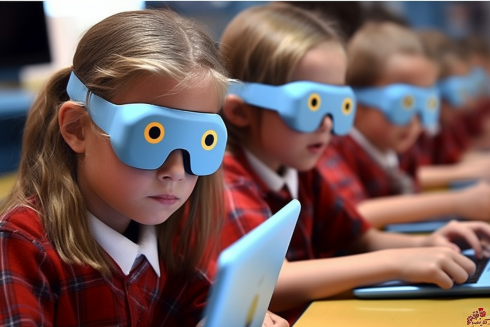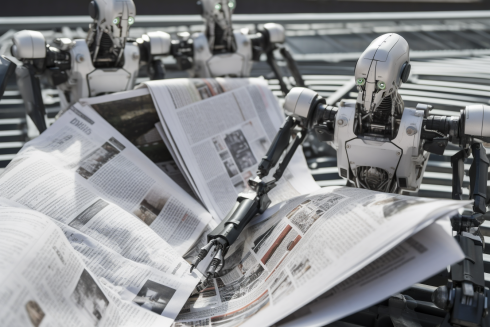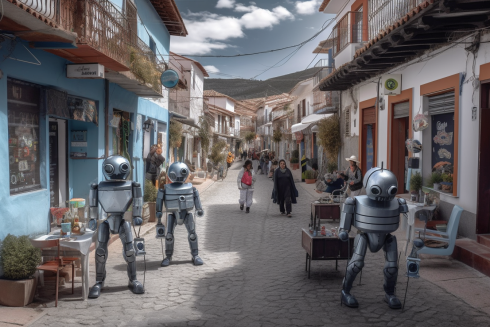ARTIFICIAL intelligence (AI) is being hailed by some people as the next industrial revolution. Others say it’s a danger to humanity and will soon get out of control.
American commentator, Joe Rogan, is currently voicing concern over a fake AI-generated podcast featuring an interview between him and the CEO of a company called OpenAI, Sam Altman.
On a similar theme, Berlin-based photographer, Boris Eldagsen, recently fooled the Sony World Photography Awards with an AI-generated photo. He won first prize in the creative category but did not accept the award, saying he has shown how even top professionals are unprepared for AI.
If you are new to AI, you won’t be for long.
Some large investors are developing it, such as Microsoft, Amazon, Google, and IBM. If you use social media, Meta is developing AI elements for Facebook and Instagram, and Snapchat is launching an AI feature for paying users.
If you use streaming services, you’re already seen the hand of AI when it suggests films or other content you might enjoy. You’ve also heard AI voiceovers on some Facebook adverts you are fed (such as Halara leisurewear).
So, with 2023 being the year of AI, how could it affect our lives ?
Here now: chat bots and image generators
Many people are signing up for the new chatbot AI apps, such as Chat GPT from OpenAI. A chatbot is an AI app where you give it prompts, or asks it questions, and it draws on a large data set to answer with the content you want (this process usually needs some refining).
The idea is that the bots can instantly ‘research’ and explain any topic in detail, and it only takes a few minutes.
The current chatbots can write articles, essays, devise book plots, and generate computer code. You can easily save yourself several hours’ work.
With image AI, the popular apps – such as DALL-E and Midjourney – use written prompts from the user to produce images. They will render anything you can describe (such as ‘Pedro Sanchez riding a Spanish bull’). And, unlike human designers using Photoshop, they do it in seconds.

Seeing this speed and efficiency of these existing apps, some people fear that AI will eventually overtake or dominate humans, plunging us into a plot worthy of Netflix’s popular series, ‘Black Mirror’.
Democratic dangers
With Spain’s local elections coming on May 28, and possibly a general election in December, this might be the last campaign period unaffected by AI. The main worry is: how will voters distinguishing real content from AI-generated propaganda?
Some voters already find it difficult to identify fake news on the ‘old’ social networks, such as Facebook, Instagram, and Twitter. As for YouTube, “I saw a video, so it must be true” has been a long-standing problem.
Now, there are AI voiceover apps, AI face generators, and you could ‘skin’ video content with someone else’s face – such as a politician.
Using a simple prompt on Midjourney, the reporter created a convincing image of “Boris Johnson DJ-ing at a rave in a dry, dusty riverbed in southern Spain”. OK, we know this would never happen but would your 80-year-old granny be so sure?

For the experienced user, generating AI deepfakes is easy. These are videos or audio recordings that show someone saying or doing something that isn’t real. Think of the old ‘mashup’ videos, where snippets of a politician’s voice were blended to make a funny song (such as Nigel Farage saying he loves Europe), only more sophisticated.
Employment – losses and gains
In the next few years, AI is likely to automate many jobs, particularly those involving repetitive tasks that rely on data sets – such as coding, paralegal research, analysis, etc.
Warehousing is another affected field, with Amazon already deploying robots called Proteus.
AI will impact art and design, as it is cheaper to use Image AI to visualise an idea than pay a human worker.
However, for now, AI is more likely to enhance than replace jobs, as humans need to oversee the processes and check the accuracy of the content – whether it’s code for an e-commerce system or a travel guide about Andalucia. Errors are widely reported.
AI will also create new jobs. These might include data scientists, AI hardware engineers, AI programmers, and people employed to input prompts to make content.
Education enhancements?
AI could be used to create ‘personalised learning experiences’ for students. This is, presumably, instead of a teacher lecturing from the front of the class. It is intended to be more engaging.
However, the use of AI in education could cause a ‘digital divide’ – according to how computer technology is provided. Some people (of all ages) already struggle to use existing mobile phone apps or can’t afford the gadgets.

A teen told the Olive Press that some ‘instituto’ students already use Chat GPT and other essay chatbots for their homework, as well as AI apps to solve maths equations. Even the teacher used an AI app on a complex maths challenge, he said.
However, savvy teachers can install their own apps to detect if homework is AI-generated. This is easy to spot, as the apps look for the the GPT-3 (or more recent GPT-4) protocol, and flag this up in submitted homework. Schools tend to hate plagiarism, so don’t abandon your traditional research methods just yet.
Chat GPT – the new office copywriter?
While Chat GPT is being hailed as an all-singing, all-dancing writing tool, the tone of its output is easily spotted. If a newspaper used it instead of humans, every article would sound the same – without the personality or charm of individual writers.

The reporter asked Chat GPT to summarise several seaside towns on the Costa Tropical. The results contained serious errors, muddling up the important historical events and landmarks.
Someone without local knowledge might miss these mistakes. Furthermore, Chat GPT’s knowledge cut-off point is September 2021, which means that some content is naturally outdated.
Despite the shortcomings, many companies already use Chat GPT to write their website content, product descriptions, blogs, and more. Although the chatbot is handy for ‘boring’ content, it isn’t a replacement for seasoned copywriters with a lively style – just yet.
Photography advances – or replacement?
AI is creeping into every area of photography – from apps that enhance your cameraphone snaps to professional-level programs that creates images from scratch, like Midjourney and DALL-E.
While colourful, fantastical images are modish these days, and the AI ‘engines’ are constantly learning and improving their accuracy, they currently don’t render text correctly. So, you can’t enter “passengers boarding Ryanair plane” and have a correct logo returned.

And… are the results a bit soulless? Some critics think so.
Professional photographer, Graham Knipe, of Granada, says: “Cameras have been slowly taking over the image creation process for years. I embrace technology, but not to the point where it completely removes any artistic interpretation – all images will end up looking the same.”
“However, I don’t think that AI will completely take over photography, just as digital never completely replaced film.”
The most obvious problem with AI image generation is that many people will think the end-result is real, leading to unanticipated situations.
Where’s it all heading?
The interest in Chat GPT has been phenomenal. Since launching in November 2022, it has attracted 100 million users. This is much faster than the growth of the ‘old style’ social networks.
The rapid spread of, and investment in, AI raises ethical, privacy, and security concerns.
But are people making too much fuss?
Remember when we were terrified of the ‘Millennium Bug’, thinking that computer systems would roll over to 0000 and destroy the world?
There was also a time when people didn’t want music to turn digital. We were eventually happy to carry around CDs, rather than bulky vinyl records, with the formats becoming smaller and more portable over the years. Pendrives, Bluetooth… life has become more convenient with progress.
Overall, the impact of AI on Spain – and the rest of the world – will depend on how it is developed and deployed. While it brings some risks, it can also make many daily tasks quicker and easier.
We might end up working more closely with machines that help us with our personalised daily tasks, and speeding up dull chores is never a bad thing.

The main AI apps in our daily lives
- Virtual assistants
- Chatbots
- Social media algorithms
- Language translation, such as Google Translate
- Personalised recommendations online
- Healthcare applications
- Smart home devices
- Navigation and ride-sharing apps, including Google Maps
- Fraud detection by banks, etc.
How does Chat GPT work?
The chat AI apps are machine learning Natural Language Processing models known as Large Language Models (LLMs). They digest massive quantities of text data and infer relationships between words.
How does image AI work?
Image AI text-to-image generators use a machine learning technique called artificial neural networks. These receive input in the form of words and processes them to form images.
READ MORE

